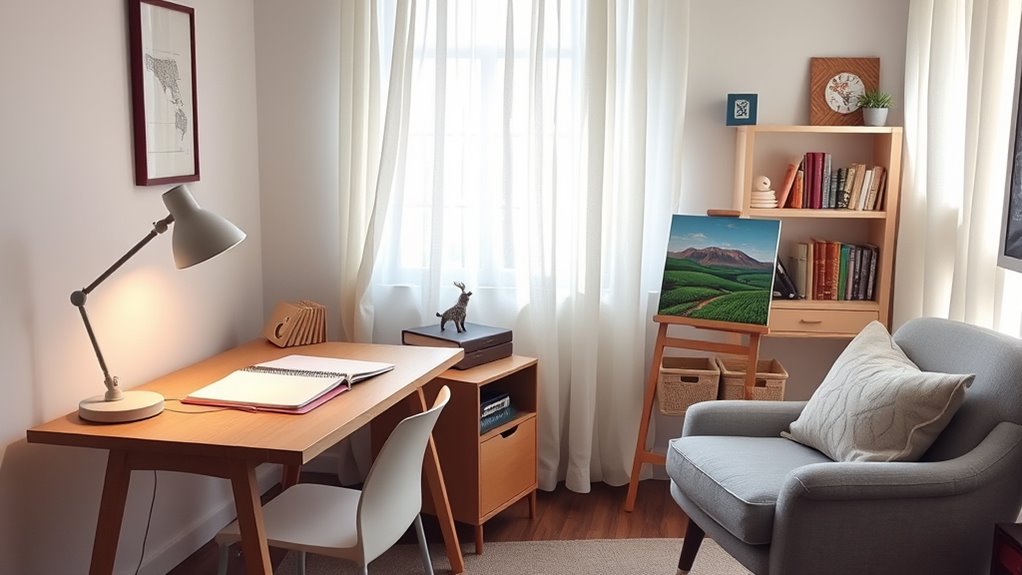Positioning homework corners next to hobby nooks helps you create a balanced and inviting space at home. This setup encourages a smooth shift between work and play, making routines more seamless and motivating. With organized storage, comfortable seating, and inspiring decor, you’ll foster focus while also promoting relaxation. By arranging these areas close together, you maximize space and support your child’s independence. Keep exploring to discover tips that make this harmony even easier to achieve.
Key Takeaways
- Placing homework corners near hobby nooks fosters a seamless transition between work and play, promoting a balanced routine.
- Proximity encourages motivation by allowing children to easily switch between study and hobbies within a shared space.
- Well-organized, adjacent areas create a functional environment that reduces clutter and enhances focus.
- Flexible layout options support personalized use, accommodating different activities and moods for sustained engagement.
- Integrating these spaces boosts independence, reduces stress, and nurtures a harmonious, productive home environment.

Creating dedicated homework corners next to hobby nooks can make your space both functional and inviting. When you arrange a specific spot for studying right beside a cozy area for hobbies, you create a seamless environment that encourages focus and relaxation. This setup allows your child or even yourself to switch effortlessly between work and play without feeling like you’re leaving one activity behind. The idea is to craft a space where productivity and creativity coexist, promoting a balanced routine that’s easy to maintain.
To make this work, start by choosing a quiet, well-lit corner in your home. Position a sturdy desk or table with enough surface area to spread out books, notebooks, and supplies comfortably. Adjacent to this, set up a hobby nook that’s inviting and inspiring—think of a small shelf with art supplies, musical instruments, or craft materials, complemented by a comfortable chair or mat. Keeping these areas close together minimizes *changeover* time and helps reinforce a habit of switching smoothly between tasks. When your child sees that their homework zone is right beside a space dedicated to their passions, it becomes a motivating factor rather than a chore.
Incorporate storage solutions that keep everything tidy and accessible. Use baskets, bins, or drawers to organize supplies, so your child doesn’t waste time hunting for pencils or coloring tools. A well-organized space reduces frustration and keeps the focus on the task at hand. Personalize the corner with motivational posters, a calendar, or a whiteboard to track assignments and goals. Adding some cheerful decor or plants can also make the area feel welcoming and reduce stress, making homework sessions less of a struggle and more of an integrated part of daily life.
Flexibility is key. You might find that your child prefers to start their homework at the desk and then move to the hobby nook for a break, or vice versa. Design the space so that it adapts to different needs and moods, encouraging autonomy. When the boundaries between work and leisure are thoughtfully blurred, your child learns to manage their time better and develops a sense of ownership over their routine. Over time, this harmony at home can foster independence, boost motivation, and make learning more enjoyable. Creating a dual-purpose space like this not only maximizes your home’s potential but also nurtures a balanced lifestyle where work and play complement each other naturally.
Frequently Asked Questions
How Do I Choose the Best Location for a Homework Corner?
You should choose a location with good natural light and minimal distractions to keep focus. Pick a quiet spot away from high-traffic areas, like near a window or in a corner of a room. Make certain there’s enough space for a desk and supplies, and consider proximity to common areas for easy supervision. This setup helps you create a productive, comfortable environment that encourages concentration and organization.
What Safety Considerations Are Important for Kids’ Hobby Nooks?
Imagine your child is crafting a model airplane in their hobby nook. To keep it safe, make certain the space is well-ventilated, especially if they work with paints or glue. Use childproof locks on storage cabinets, and keep sharp tools out of reach. Regularly check for loose screws or broken equipment. These precautions protect your kids from accidents and create a secure environment for their creative exploration.
How Can I Organize Space Efficiently in Small Homes?
To organize space efficiently in small homes, you should maximize vertical storage by using shelves and wall-mounted organizers. Declutter regularly to keep only essentials, and opt for multi-functional furniture like beds with drawers or fold-out desks. Use clear bins or labeled containers to easily find items, and create dedicated zones for activities. Combining these strategies helps you make the most of limited space while keeping your home tidy and functional.
What Are Some Budget-Friendly Ideas for Decorating Homework Areas?
You can create budget-friendly homework areas by repurposing items you already have, like using a sturdy table from your garage or buying secondhand furniture. Add inexpensive storage solutions like plastic bins or wall-mounted shelves to keep supplies organized. Decorate with DIY art or printable posters to personalize the space. Using affordable lighting, such as desk lamps or string lights, also brightens the area without breaking the bank.
How Can Noise Levels Be Minimized Between Homework and Hobby Spaces?
Want to keep noise levels down between your homework and hobby spaces? Try adding soft furnishings like rugs, curtains, or plush cushions to absorb sound. You can also install bookcases or fabric-covered wall panels as acoustic barriers. Have you considered creating a small buffer zone with a bookshelf or a folding screen? These simple steps help reduce noise, making each area more focused and peaceful for studying or hobbies.
Conclusion
By combining your homework corner next to a hobby nook, you create a space that boosts focus and sparks creativity. Studies show that organized, personalized areas can improve productivity by up to 25%. So, take a moment to design your perfect harmony at home—where learning and leisure coexist seamlessly. With just a few tweaks, you’ll turn everyday spaces into inspiring environments that motivate you to excel and unwind effortlessly.









